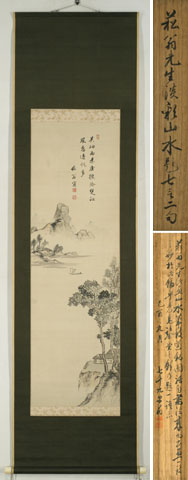Nanga
Southern Chinese landscapeSigned: Sûô sha
Seals: Kanboku Seifuku, Hôchiku Jôsha, Shûsui (top)
Technique: colours on silk 116 x 36,3
Mounting: green damask 188 x 51,4
Box: Autorised in September 1909 by Kaioku’s pupil Kobayashi Takusai (1831-1916).
Condition: a faint stain, otherwise very good
The poem reads:
Rain is coming to the peaks of Wu
It is cold on the empty terrace
Wind is whipping the River of Chu
Many sails in the distance.
Kaioku was born as the second son of a martial arts teacher in the service of the Hachisuka domain in Awa Province. Although he was educated in the family tradition of martial arts, his weak constitution allowed him to follow Confucian studies, poetry and calligraphy.
After a brief training in Kanô painting he went to Nagasaki to study Nanga painting under the Zen-monk Hidaka Tetsuô (1791-1871). He chose to be a Confucian scholar for which he studied in several parts of Japan for many years of his life. For three years he studied calligraphy. He copied the style of the 9th century monk Kôbô Daishi permanently and mastered all the styles of calligraphy. After the death of Rai San'yô (1780-1832), Kaioku became the most celebrated bunjin artist in Kyoto.
In each of the editions of the Heian Jinbutsu shi from 1813 until 1852 Kaioku is mentioned twice as a poet as well as a calligrapher. In 1811 he settled in Kyoto where in 1828 he finally established the Suseidô, his own school.
Reference:
Rosenfield B.68
Berry & Morioka ’08 p. 287-88
Hempel p. 165
Roberts p. 64
Price: ON REQUEST

